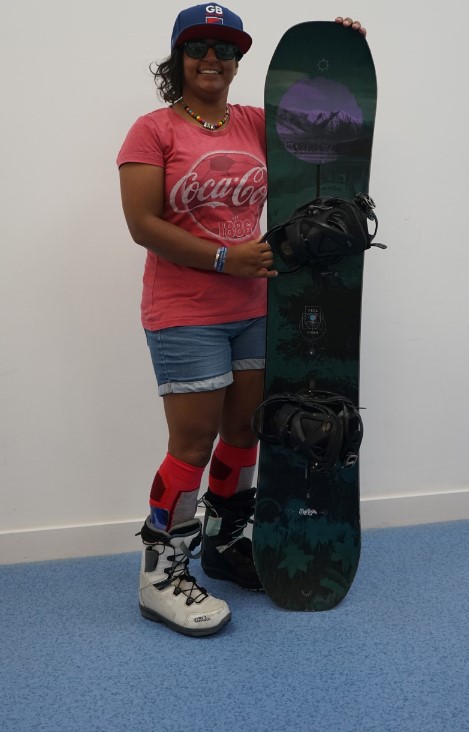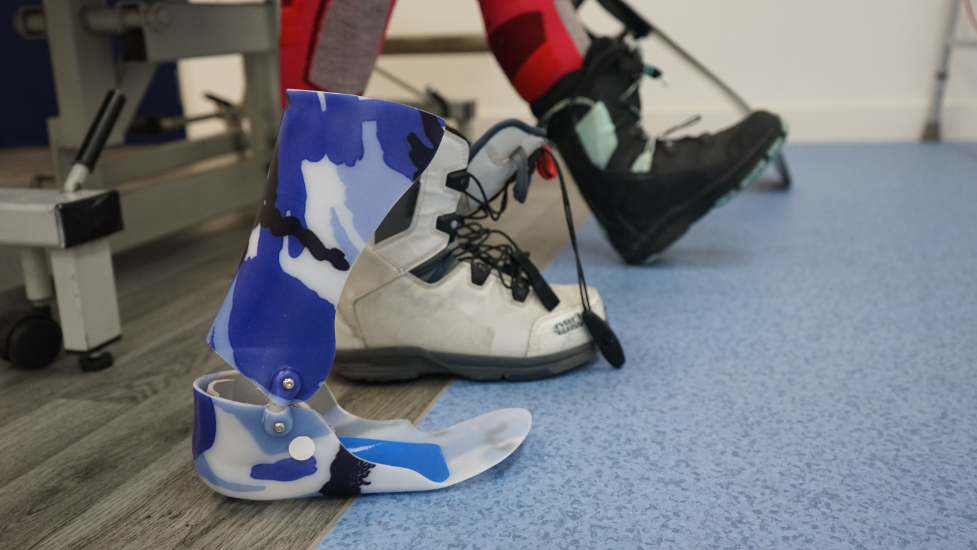
20 September 2022
Nina Sparks has been snowboarding since the age of thirteen. Unfortunately, in 2021 she was diagnosed with Multiple Sclerosis. She was living in Austria at the time for snowboard training and started to feel numb in her right foot. This feeling of numbness spread up her body to her rib cage. The final prompt to seek medical help was when she sat on a heated chair lift and could not feel the heat, to the astonishment of her fellow snowboarder. Nina was duly assessed at Innsbruck hospital where after various MRI scans and other tests she was told she had MS. Worse still her right foot was permanently damaged.
By the time Nina came to see LOC in April of this year, she was really struggling with her walking but was determined to continue to snowboard, with the objective of getting into the GB Paralympic snowboard team.
Nina ‘found’ LOC because she just happened to be following an LOC patient on Instagram, he had suffered a severe spinal injury but was determined to do as much mountaineering as possible with the ultimate goal of walking up Everest. Nina thought that if LOC could help him achieve his goal then they might be able to help her.
We will let Nina take up the story: “First I had an assessment of my leg and ankle function followed by a session in LOC’s Gait Lab which used some pretty cool cameras and high tech stuff to show how I walk and which part of my foot my weight goes through at each part of a footstep. This highlighted a few issues I have, one of which is drop foot and the other is that my leg isn’t straightening properly so my foot isn’t flat on the floor when I walk or stand.”
Anna Courtney, one of LOC’s senior orthotists, prescribed a carbon fibre AFO for Nina. Within three weeks it had broken. As Nina explains: “Apparently it turns out that rigid carbon fibre is not suitable for the off- snow training required of a para snowboarder!!” Anna’s solution was to prescribe a Neuroswing AFO which has an ankle joint controlled by springs. This has proved more sturdy and Nina comments: “It’s amazing, truly life changing. As my mum so kindly puts it ‘you’re walking like a normal person again’.”
As the Neuroswing is not actually suitable wear for snowboarding, the next step was a challenging operation to make an orthosis that would fit inside a snowboard boot. After an at times hilarious casting for this – just imagine layers of socks, cling film, quick setting plaster and more cling film and a foot jammed into a snowboard boot – we had a cast that could be given to LOC Manufacturing to start making this unique orthosis.
Nina was fitted with her snowboarding AFO in August. It has a hinge on it so Nina’s ankle is more flexed. “The AFO fitted perfectly straight away and immediately I could feel it working, pushing against my calf to flex my ankle in my boot, something which hasn’t happened for over a year!!”
Nina has been testing her new AFO out at the SnowZone in Milton Keynes and The Snow Centre at Hemel Hempstead in preparation for joining the Para Snowboard Team in Spain for training on 18th September. We wish her luck in her endeavours to gain selection to the GB team. You can follow Nina on Instagram @snowyoda_gb.

You or your child may benefit from the guidance of the LOC team's skilled clinicians, who also have access to our Gait Lab facilities in Kingston and Salford, if they have multiple sclerosis or any other neurological condition. Contact us to learn more about the various ways that custom orthotics can benefit persons who have multiple sclerosis or for a free introductory video consultation.
An AFO is an Ankle Foot Orthosis which as the name would suggest encompasses the ankle and foot. The objective is to control the position and movement of the ankle. AFOs are used to support weak limbs; they can also be used to immobilise the ankle and lower leg to correct foot drop. When set up correctly they can also have a great influence on the knee and hip joints. They are the most commonly used Orthoses.
The length of time that one needs to wear an AFO very much depends on the condition being treated. If it is a long-term condition like cerebral palsy or post-polio syndrome it is likely to be years as the condition cannot be cured. Your orthotist will advise you.
A patient’s comfort in their AFO is vital for compliance with the prescribed wearing regime.
So there are a number of steps the orthotist should take to ensure a comfortable fit: the patient’s heel should fit fully into the heel cup without excess space, the contours of the plantar surface of the AFO should match the patient’s foot, for children there needs to be up to half an inch growth room in the toe shelf length. At LOC we use our Gait Laboratories at our Kingston and Manchester clinics to fine-tune our bespoke orthotics.
A GRAFO is used to control instabilities in the lower limb by maintaining proper alignment of limbs and controlling their motion. It reaches around to the front of the knee extending down to the ankle. It works by altering a patient’s limb presentation to displace load and impact as well as offering further control to the knee.
The cost of an AFO is dependent on the type of AFO that has been prescribed and the material that it has been made with. Carbon fibre will be more expensive than metal or plastic for example. LOC’s bespoke AFOs cost can be found on our Orthotic Prices page.
The ability to drive while wearing an AFO is dependent on the condition being treated and the orthosis that has been prescribed. If wearing a hinged AFO, for example, you will be able to drive, but if wearing a knee brace, you won’t. Your orthotist will advise you.
The most flexible type of AFO is a Dynamic Ankle Foot Orthosis (DAFO). It is thin and provides flexible support to the foot and ankle.
Both normal AFOs and DAFOs improve static balance (eg: while standing). Research among MS sufferers suggests that DAFOs aided balance while walking more than AFOs.
The simple answer is: yes they can. However one has to be sensible and look for wide-fitting trousers/jeans preferably of light and thin material.
Typically an AFO is stiff and rigid whereas a DAFO is thin, flexible and wraps around the patient’s entire foot. A DAFO provides support but also allows some range of normal movement.
A Supra Malleolar Orthosis SMO gets its name from the part of the body it encompasses. Thus an SMO supports the leg just above the ankle bone or malleoli. It allows dorsiflexion and plantar flexion(toes up and toes down) but eliminates mediolateral movement.
It typically takes a few weeks but is slightly dependent on the chosen materials and current availability.